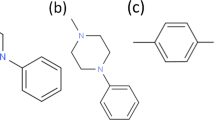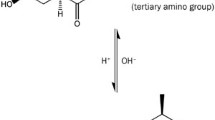Abstract
In an attempt to establish an in vitro/in situ correlation of intestinal permeability data, the permeability coefficients (P app) for a series of model peptides, which were determined using an in situ perfused rat ileum model, were compared to the permeability coefficients (P mono) determined using an in vitro cell culture model (Caco-2). The model peptides, which were all blocked on the N-terminal (acetyl, Ac) and the C-terminal (amide, NH2) ends, consisted of D-phenylalanine (F) residues (e.g., AcFNH2, AcFFNH2, AcFFFNH2). To alter the degree of hydrogen bonding potential, the nitrogens of the amide bonds were sequentially methylated [e.g., AcFF(Me)FNH2, AcF(Me)F(Me)FNH2, Ac(Me)F(Me)F(Me)FNH2, Ac-(Me)F(Me)F(Me)FNH(Me)]. These peptides were shown not to be metabolized in the in situ perfused rat ileum system. The results of the transport experiments showed that there were poor correlations between the apparent permeability coefficients (P app) determined in an in situ perfused rat ileum model and the octanol–water partition coefficients (r = 0.60) or the hydrogen bonding numbers (r = 0.63) of these peptides. However, good correlations were observed between the in situ P app values for these peptides and their partition coefficients in heptane–ethylene glycol (r = 0.96) and the differences in their partition coefficients between octanol–water and isooctane–water (r = 0.86). These results suggest that lipophilicity may not be the major factor in determining the intestinal permeability of these peptides and that hydrogen bonding potential may be a major contributing factor. A good correlation (r = 0.94) was also observed between the P app values determined for these peptides in the in situ perfused ileum model and those P mono values determined in the in vitro cell culture model (Caco-2) (Conradi et al., Pharm. Res. 8:1453–1460, 1991). These results suggest that the permeability values determined in the Caco-2 cell culture model may be a good predictor of the intestinal permeability of peptides.
Similar content being viewed by others
REFERENCES
C. Oliyai, C. Schoneich, G.-S. Wilson, and R. T. Borchardt. Chemical and physical stability of protein pharmaceuticals. In D. J. A. Crommelin and K. K. Midha (eds.), Topics in Pharmaceutical Sciences 1991, Med. Pharm. Scientific, Stuttgart, 1992, pp. 23–46.
V. H. L. Lee (ed.). Peptide and Protein Delivery, Marcel Dekker, New York, 1991.
V. H. L. Lee and A. Yamamoto. Penetration and enzymatic barriers to peptide and protein absorption. Adv. Drug. Deliv. Rev. 4:171–207 (1990).
H. Nellans. Paracellular intestinal transport: Modulator of absorption. Adv. Drug. Deliv. Rev. 7:339–364 (1991).
P. S. Burton, R. A. Conradi, and A. R. Hilgers. Transcellular mechanism of peptide and protein absorption: Passive aspects. Adv. Drug. Deliv. Rev. 7:365–386 (1991).
I. J. Hidalgo, T. J. Raub, and R. T. Borchardt. Characterization of the human colon carcinoma cell line (Caco-2) as a model system for intestinal epithelial permeability. Gastroenterology 96:736–749 (1989).
G. Wilson, J. F. Hassam, C. J. Dix, I. Williamson, R. Shah, M. Mackay, and P. Artursson. Transport and permeability properties of human Caco-2 cells: An in vitro model of the intestinal epithelial cell barrier. J. Control. Release 11:25–40 (1990).
A. R. Hilgers, R. A. Conradi, and P. S. Burton. Caco-2 cell monolayer as a model for drug transport across the intestinal mucosa. Pharm. Res. 7:902–910 (1990).
P. Artursson. Epithelial transport of drugs in cell culture. I. A model for studying the passive diffusion of drugs over intestinal absorptive (Caco-2) cells. J. Pharm. Sci. 79:476–482 (1990).
R. A. Conradi, A. R. Hilgers, N. F. H. Ho, and P. S. Burton. The influence of peptide structure on transport across Caco-2 cells. Pharm. Res. 8:1453–1460 (1991).
P. S. Burton, R. A. Conradi, A. R. Hilgers, N. F. H. Ho, and L. L. Maggiora. The relationship between peptide structure and transport across epithelial cell monolayers. J. Control. Release 9:87–98 (1992).
R. A. Conradi, A. R. Hilgers, N. F. H. Ho, and P. S. Burton. The influence of peptide structure on transport across Caco-2 cell. II. Peptide bond modification which results in improved permeability. Pharm. Res. 9:435–439 (1992).
M. S. Karls, B. D. Rush, K. F. Wilkinson, T. J. Vidmar, P. S. Burton, and M. J. Ruwart. Desolvation energy: A major determinant of absorption, but not clearance, of peptides in rats. Pharm. Res. 8:1477–1481 (1991).
W. Rubas, N. Jezyk, and G. M. Grass. Comparison of the permeability of a human colonic epithelial (Caco-2) cell line to colon of rabbit, monkey and dog intestine and human drug absorption. Pharm. Res. 10:113–118 (1993).
P. Artursson and J. Karlsson. Correlation between oral drug absorption in humans and apparent drug permeability coefficients in human intestinal epithelial (Caco-2) cells. Biochem. Biophys. Res. Commun. 175:880–885 (1991).
K. R. Buttleworth and D. Pelley. Mesenteric venous blood sampling in vivo in the rat. J. Physiol. 232:60P–61P (1973).
K. C. Yeh and K. C. Kwan. A comparison of numerical integrating algorithms by trapezoidal, Lagrange, and spline approximations. J. Pharmacokinet. Biopharm. 6:79–98 (1978).
N. F. H. Ho, J. S. Day, C. L. Barsuhn, P. S. Burton, and T. J. Raub. Biophysical model approaches to mechanistic transepithelial studies of peptides. J. Control. Release 11:3–24 (1990).
W. D. Stein. The molecular basis of diffusion across cell membranes. In The Movement of Molecules Across Cell Membranes, Academic Press, New York, 1967, pp. 65–125.
P. S. Burton, R. A. Conradi, A. R. Hilgers, and N. F. H. Ho. Evidence for a polarized efflux system for peptides in the apical membrane of Caco-2 cells. Biochem. Biophys. Res. Commun. 190:760–766 (1993).
Author information
Authors and Affiliations
Rights and permissions
About this article
Cite this article
Kirn, DC., Burton, P.S. & Borchardt, R.T. A Correlation Between the Permeability Characteristics of a Series of Peptides Using an in Vitro Cell Culture Model (Caco-2) and Those Using an in Situ Perfused Rat Ileum Model of the Intestinal Mucosa. Pharm Res 10, 1710–1714 (1993). https://doi.org/10.1023/A:1018961828510
Issue Date:
DOI: https://doi.org/10.1023/A:1018961828510




